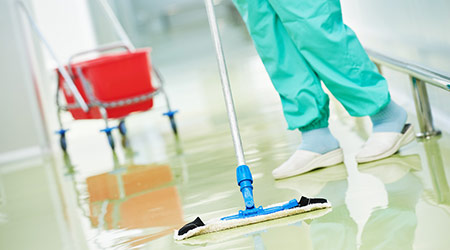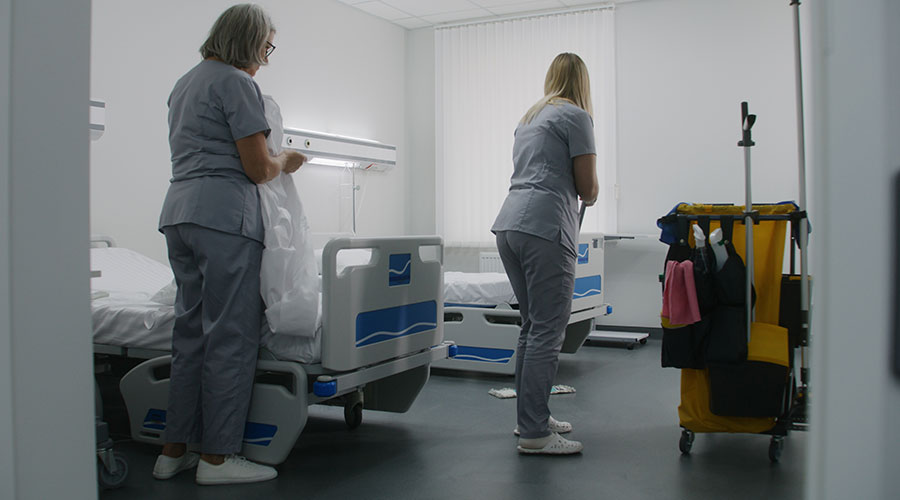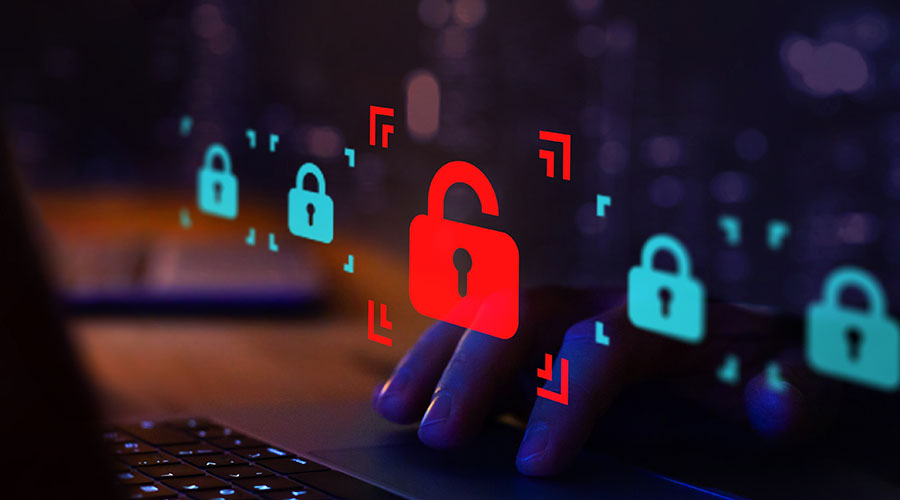Healthcare associated infections (HAIs) continue to be a global burden with significant patient outcomes and costs. Despite the many interventions and strategies put into place to mitigate HAIs, they remain problematic. In 2011, an estimated 722,000 HAIs were reported in U.S. acute care hospitals along with approximately 75,000 patient deaths.¹
Efforts to minimize device-related HAIs such as central line associated bloodstream infections (CLABSIs), catheter associated urinary tract infections (CAUTI) and ventilator associated pneumonia (VAP) have made considerable improvements over the past few years due to a concerted focus on device utilization and proper maintenance. However, other HAIs such as non-ventilator associated pneumonia, Clostridium difficile infections (CDI) and surgical site infections (SSIs) still have a substantial need for improvement.²
Most HAI prevention strategies contain an environmental cleaning and disinfection component. The mounting evidence linking HAIs with the healthcare environment has put a large spotlight on cleaning and disinfection. Many common HAI-related microorganisms have been linked to person-to-person transmission due to contamination of the hospital environment. Pathogens such as MRSA, VRE, C. difficile, Acinetobacter spp., and norovirus have been shown to contaminate and survive for long periods of time on environmental surfaces.³
Unfortunately, environmental cleaning has been shown to be inadequate in several studies, demonstrating that less than 50% of hospital rooms are effectively cleaned and disinfected with germicides.⁴
Some of the issues that lead to inadequate environmental cleaning involve difficulties with staffing, unclear ownership, incorrect supplies, budget cutbacks, lack of training or continuing education, and an absence quality control. Many environmental service (EVS) staff are undermanned and suffer from high turnover. This makes training and education a continual challenge. Additionally, with lack of staff and constant budget restraints, many facilities are doing more in less time. Overall, breaks in environmental cleaning will continue to occur without solid interventions.
While there are many roadblocks to good environmental cleaning, there are also many intervention strategies to increase environmental cleaning compliance and efficacy. Weber, et al states that adequately following a few interventions “improves the frequency of adequate cleaning in the range of 71-77%”:
1. Improving EVS education and training;
2. Making checklists that ensure all surfaces, medical devices, and equipment are cleaned and disinfected adequately; where ownership is clearly defined (EVS or nursing, etc.);
3. Environmental cleaning assessments with fluorescence or ATP testing evaluate the effectiveness of cleaning with real-time feedback to EVS workers.⁵
Additionally, the Centers for Disease Control and Prevention (CDC), provides a toolkit for evaluating environmental cleaning that can assist in improving outcomes.⁶
Another important aspect of compliance involves cleaning/disinfectant product choice. Cleaning compliance has been shown to significantly increase with ready-to-use cleaning/disinfection products.⁴ One study mentioned by Kenters, et al showed a reduction of HAIs with the use of cleaning disinfection wipes when compliance reached 80%.⁴
Special focus: The Perioperative Environment
One area that is often a keen focus of environmental cleaning in healthcare is the operating room (OR). Over the past few years, surgical site infection prevention has received a great deal of attention. Surgical site infections (SSIs) entered this spotlight because they were the most common healthcare associated infection (HAI), yielding 31% of all HAIs among hospitalized patients.⁷ The SSI rate complication for all surgical procedures in the United States between 2006-2009, was approximately 1.9%.⁸ But, it’s likely that the impact is much greater due to roughly 50% of SSIs emerging after discharge.⁸ Since 2011, a significant decrease in SSIs has occurred, indicating that national efforts to decrease SSI are proving to be very effective.² However, they are still a top priority due to their overall impact on patients and healthcare. Not only can SSIs cost from $3.5 billion to $10 billion annually in healthcare expenditures, they also have an estimated mortality rate of 3%.⁷ ⁹ Even more troublesome is that 75% of SSI associated deaths are directly attributable to the SSI.⁷
There are many risk factors that can lead to a SSI. These risk factors can be grouped into two categories: patient related and procedure related. Many patient-related factors can be more difficult to control. Yet procedure-related factors such as skin prep, antibiotic prophylaxis, aseptic technique and the operating room (OR) environments are often easier to regulate.⁹ The OR environment necessitates meticulous cleaning and disinfection for the prevention of SSIs. In a fast paced OR, the room turnover between cases can present a challenge. Rapid room turnovers are fiscally important for healthcare facilities so that they can maximize cases in an efficient manner. Room turnover necessitates thorough cleaning and disinfection of the OR suite, instruments and equipment. However, with the rapid nature of the turnovers, thoroughness of cleaning and disinfection can become an issue. Compliance with cleaning and disinfection standards as well as manufacturer germicidal guidelines for use can often be compromised when speed is a driving priority.
The Association of periOperative Registered Nurses (AORN) notes that cleaning practices in the OR are not always followed consistently, citing a study demonstrating an average cleaning rate of only 25% for objects monitored.¹⁰ AORN has specific guidelines that outline recommendations for environmental cleaning in the perioperative setting. The guidelines address cleaning procedures, germicidal choice, education and competency, policies and procedures, and quality assurance/ performance improvement processes. Some key perioperative environmental cleaning recommendations of note include:
1. Establish a multidisciplinary team to carry out cleaning procedures and ensure proper policies, education, and compliance monitoring is in place.
2. Ensure appropriate cleaning of the environment after transferring patient out of the area.
• This includes proper cleaning of all areas in the OR suite, including equipment and devices used.
3. Conduct daily terminally cleaning of perioperative areas after the last procedure of the day or night.
4. Clean all other areas and equipment on an established schedule.
• This includes storage supply areas, bins, soiled utility rooms, lounges, closets, refrigerators, ice machines, etc.
5. Perform environmental cleaning and handle waste materials in a manner that limits the spread of pathogens.
• Cleaning in the OR should progress from clean to contaminated; top to bottom; in a clockwise or counter-clockwise fashion.
6. Have environmental cleaning procedures in place for special pathogens and situations in place such as multidrug-resistant organisms, C difficile, prion diseases, and construction.¹⁰
The significant role of the healthcare environment and the correlation with HAIs is undeniable. By incorporating evidence based infection prevention strategies for environmental cleaning and disinfection, healthcare facilities obtain greater success in overall quality, compliance, and efficiency. More importantly, improved environmental cleaning promotes positive patient outcomes and fewer HAIs.
Deva Rea is is a Clinical Science Liaison for PDI.
¹Magill, S. S., Edwards, J. R., Bamberg, W., Beldavs, Z. G., Dumyati, G., Kainer, M. A., ... & Ray, S. M. (2014). Multistate point-prevalence survey of health care–associated infections. New England Journal of Medicine, 370(13), 1198-1208.
²Magill, Shelley S., et al. "Reduction in the Prevalence of Healthcare-associated Infections in US Acute Care Hospitals, 2015 vs 2011." Open forum infectious diseases. Vol. 4. No. suppl_1. US: Oxford University Press, 2017.
³David J. Weber, William A. Rutala, Hajime Kanamori, Maria F. Gergen and Emily E. Sickbert-Bennett (2015). Carbapenem Resistant Enterobacteriaceae: Frequency of Hospital Room Contamination and Survival on Various Inoculated Surfaces. Infection Control & Hospital Epidemiology, 36, pp 590-593 doi:10.1017/ice.2015.17
⁴Kenters, N., Huijskens, E. G., de Wit, S. C., van Rosmalen, J., & Voss, A. (2017). Effectiveness of cleaning-disinfection wipes and sprays against multidrug-resistant outbreak strains. American journal of infection control, 45(8), e69-e73.
⁵Weber, D. J., Anderson, D., & Rutala, W. A. (2013). The role of the surface environment in healthcare-associated infections. Current opinion in infectious diseases, 26(4), 338-344.
⁶ Centers for Disease Control and Prevention. Guh, A., & Carling, P. (2010). Options for evaluating environmental cleaning. Accessed June 8, 2018 from: https://www.cdc.gov/hai/toolkits/evaluating-environmental-cleaning.html
⁷National Healthcare Safety Network, Centers for Disease Control and Prevention. Surgical Site Infection (SSI) Event. Published January 2018. Procedure-associated Module SSI. Accessed June, 6, 2018 from: https://www.cdc.gov/nhsn/pdfs/pscmanual/9pscssicurrent.pdf
⁸Berríos-Torres SI, Umscheid CA, Bratzler DW, et al. Centers for Disease Control and Prevention Guideline for the Prevention of Surgical Site Infection, 2017. JAMA Surg. 2017;152(8):784–791. doi:10.1001/jamasurg.2017.0904
⁹Anderson, Deverick J., et al. "Strategies to prevent surgical site infections in acute care hospitals: 2014 update." Infection Control & Hospital Epidemiology 35.S2 (2014): S66-S88. http://www.jstor.org/stable/10.1086/676022
¹⁰Association of Operating Room Nurses. Guidelines for Perioperative Practice: Environmental Cleaning. (2015). Denver, CO: AORN

 Disinfectant Dispensers in Healthcare Facilities Often Fail to Deliver Safe Concentrations: Study
Disinfectant Dispensers in Healthcare Facilities Often Fail to Deliver Safe Concentrations: Study Duke University Health System Receives $50 Million for Proton Beam Therapy Center
Duke University Health System Receives $50 Million for Proton Beam Therapy Center UT Southwestern Experiences Data Breach Through Calendar Tool
UT Southwestern Experiences Data Breach Through Calendar Tool Protecting Patient Data: Strategies and Tactics
Protecting Patient Data: Strategies and Tactics Duke Health to Acquire Lake Norman Regional Medical Center
Duke Health to Acquire Lake Norman Regional Medical Center